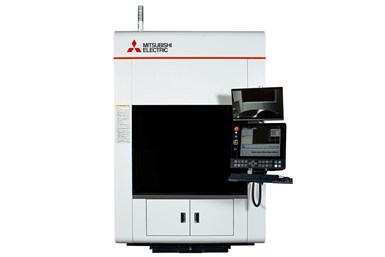Wire-Laser Metal 3D Printer for Efficient, Versatile Processing
The MC Machinery Systems printer applications include rapid prototyping, mold and die, one-offs, short runs, mass manufacturing, maintenance, repair, tooling and more.
MC Machinery Systems’ Mitsubishi AZ600 wire-laser metal 3D printer. Photo Credit: MC Machinery Systems
MC Machinery Systems’ Mitsubishi AZ600 wire-laser metal 3D printer melts welding wire with a laser beam to create high-quality 3D structures, producing high-speed, high-precision 3D printing while reducing energy consumption and waste. The printer applications include rapid prototyping, mold and die, one-offs, short runs, mass manufacturing, maintenance, repair, tooling and more.
With the same proprietary wire-feeding technology used in Mitsubishi’s industry-leading wire EDMs, a simple command on the machine’s CNC control feeds the exact amount of wire to the target location. Unlike other 3D printers, the wire is in the front of the machine to make it easier to replace, the company says.
The machine uses commercially available welding wire as the feedstock and features Mitsubishi’s laser oscillator and processing head to prevent material oxidation. A low-spatter process keeps the inside of the machine clean, while parts manufactured using other processes can be incorporated into the 3D printing process, making it effective for buildup welding
It is said wire-laser metal 3D printing is a more efficient and versatile process than powder-based metal 3D printing. It offers a number of advantages, including higher deposition rates, better surface finish, reduced porosity, better mechanical properties and reduced powder waste.
Additionally, wire-laser metal 3D printing is much safer to operate because it doesn’t use potentially flammable and explosive powder. And, because wire-laser metal 3D printing is a closed system, the metal powder is contained within the printer, thereby reducing the risk of operator exposure.
Related Content
-
MMT Chats: 4 Keys to a Successful Mold-Building Operation: Innovation, Transparency, Accessibility and Relationship
MoldMaking Technology Editorial Director Christina Fuges chats with Steve Michon, co-owner of Zero Tolerance in Clinton Township, Michigan, about the excitement of solving problems, the benefits of showing gratitude, the real struggle with delegation and the importance of staying on top of technology. This episode is brought to you by ISCAR with New Ideas for Machining Intelligently.
-
Large Hybrid Steel Insert Solves Deformation, Dimensionality, Cycle Time Problems
DMLS printers using metal additive powders selected by Linear AMS to produce high-quality, accurate, consistent 3D-printed mold components with certification and traceability.
-
MMT Chats: The Connection Between Additive Manufacturing Education and ROI
This MMT Chat continues the conversation with Action Mold and Machining, as two members of the Additive Manufacturing team dig a little deeper into AM education, AM’s return on investment and the facility and equipment requirements to implement AM properly.
















